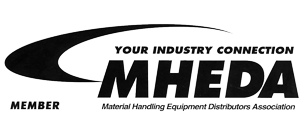So, You Bent Your Forklift Forks. What Now?
August 21, 2020 - Last modified: July 26, 2022 @ 3:17 pmForklift forks are the key to functioning equipment. These forks, or forklift tines, are responsible for lifting and carrying heavy loads. When their structure is compromised, safety is at risk.

Operators should perform routine inspections to ensure that the equipment is safe to use. If something is broken, take the forklift out of service until forklift maintenance is complete.
Keep in mind that bent forklift forks aren’t always visible to the naked eye. Pallet forks can bend on any axis, so a bent fork may not be visible from every angle. If the angle of your forklift forks is greater than 93 degrees, your forks are bent.
Proper forklift maintenance and care are critical to the health of your equipment, but things happen. Keeping your equipment in good working order isn’t always easy. If you’ve found yourself with bent forklift forks, you’re in the right place.
Forklift Inventory is your go-to source for industry information. We’ll guide you through the struggles of bent forklift forks, and arm you with the tips and tricks you need to avoid the issue altogether.
Take care of your forklift forks every time you operate your equipment. Learn more about how to maintain pallet forks below.
How to Address Bent Forklift Forks
The short answer is - it's time to look for replacement forks. You’ve probably seen videos online of people heating and bending their pallet forks. Some people have gone as far as to weld their forklift tines with a hydraulic press.
While this may appear to be a quick fix, the integrity of the steel is lost with heat. Once compromised, the integrity of the forks is gone forever. Just because forklift tines look like they once did doesn’t mean they’ll have the same strength. If you “fix” your forks with heat, you’ll never know their new forklift capacity. Therefore, you’ll never be able to operate safely.
Not only is reshaping forklift forks dangerous, but it is strictly against OSHA regulations. In fact, OSHA explicitly states, “Modifications and additions which affect capacity and safe operation shall not be performed by the customer or user without the manufacturer’s prior written approval.”
This mandate covers forklift blades as well. More often than not, the right choice is a replacement. If you have a question or concern about the integrity of your pallet forks, contact your manufacturer.
Though it may be tempting, a DIY fix is not a reliable or viable option. Instead, it is incredibly dangerous. Spend the couple hundred dollars to invest in new forklift blades if yours are bent.
How to Avoid Bends in the Future
The most common causes for bent forklift forks are collisions, improper loading, and overloading. Understanding these issues and how to avoid them can prevent you from having to replace your forklift blades again in the future.
Taking care of your equipment starts with proper forklift maintenance. Routinely servicing your forklift can help mitigate small issues before they become dangerous ones. Operators should perform an overall forklift inspection daily. They should do a more in-depth inspection once a year.
A yearly inspection of forklift forks should include the following:
1. Check the blade and shank angle. If greater than 93 degrees, replace your forklift forks.
2. Visually assess the forks, looking for surface cracks, especially near the heel and welds. Make sure the blade and shank are straight.
3. Measure tip height to ensure that the tips of each forklift blade are roughly the same height. If the difference exceeds 3% of the length of the blade, it’s time for a replacement.
4. Measure the thickness of each blade with calipers. Once your forklift blades hit 10% wear, the load capacity is reduced by 20% and replacement is necessary.
5. Use calipers to check the wear on fork hooks. Replacement your forks if the lip of the hook touches the back of the caliper.
Another big part of preserving your forklift blades is operating within your equipment’s means. Always follow manufacturer guidelines, especially when it comes to forklift load capacity. Keep in mind that load capacity changes as the load center does. Refer to the capacity chart on your equipment for guidance.
Here are some best practices that help promote forklift maintenance:
- Protect the heel of your forklift forks. The majority of the load weight is carried here.
- Use forks only for lifting, not to push objects or pry open doors.
- Never exceed maximum load capacity. Refer to your equipment’s load capacity chart.
- Lower pallet forks at a moderate rate. Bringing them down too fast or forcefully can damage your forks.
- Always use both forks, as using just one puts too much pressure on it.

Where to Find the Best Forklift Equipment
Buying quality forklifts is the starting point of maintaining a safe work environment. Knowing when to replace your equipment is also critical to the success of your business.
Forklift maintenance can only get you so far. Be sure to invest in reliable equipment from the beginning. To do this, you’ll need to find a trustworthy dealer. Buying from someone you can trust is a great way to ensure that your forklift is in good condition, especially you’re buying used.
Forklift Inventory can help. We offer the largest inventory of new and used forklifts for sale nationwide. Simply let us know what you’re looking for and we’ll match you with equipment that fits your needs.
Compare Pricing on New & Used Forklifts for Sale Near You.
Compare Forklift Prices
Forklift Inventory has the largest online selection of forklifts, aerial lifts and construction forklifts. Compare new and used forklifts to get the lowest prices available.




